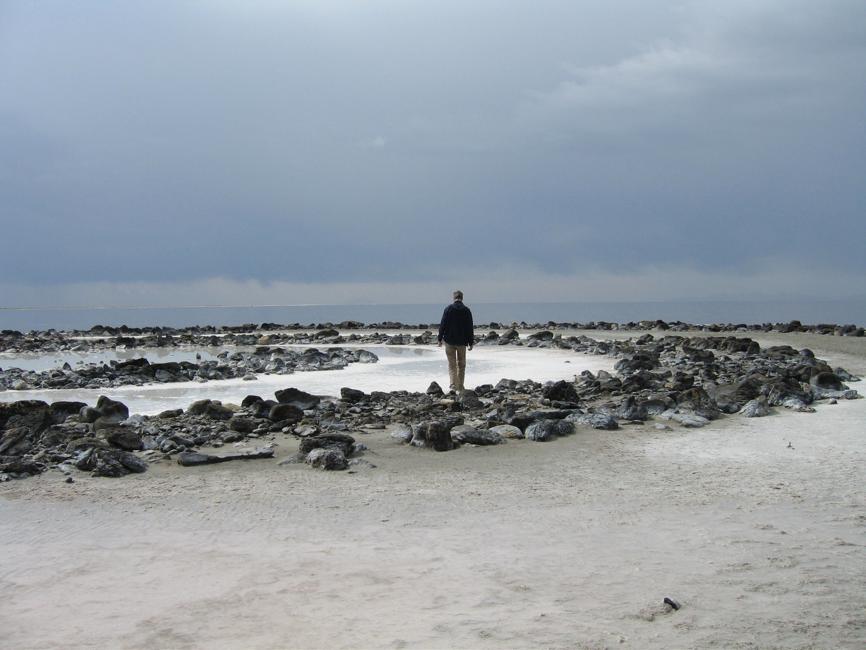
WHITE SANDS: Experiences From the Outside World
By Geoff Dyer
Pantheon, 233 pp., illustrated, $25
Reasons for traveling can be mundane and petty or cosmic and transformative — the best margarita, the holiest mountain; a much-needed escape from the ordinary or a long-anticipated encounter with an exotic obsession.
But in the case of renowned critic and writer Geoff Dyer and his latest collection of essays, “White Sands: Experiences From the Outside World,’’ it’s not immediately clear exactly what the author is seeking as he tromps around the planet on self-described “adventures’’ and “pilgrimages,’’ words that seem to be more evocative than literal. For Dyer, adventure can mean a bad hotel or an exhausting museum, or the possibility, ignited by the glimpse of a woman’s armpit, of a sexual liaison in Beijing. Pilgrim can translate as a visitor with an overactive mind who’s compelled to blurt out something opaque about his destination — and the spirituality of any journey threatens to be buried under a cascade of ramblings.
Dyer, the British author of four novels and nine works of nonfiction, whose career has been the recipient of an Easter basket full of awards and ribbons, often seems to launch himself into the world for the sole purpose of finding something new to complain about. “Our spirits worsened,’’ Dyer writes in “Northern Dark,’’ recounting a trip with his wife to an Arctic Circle base camp in the Svalbard archipelago to view the Northern Lights, and though it would be a bit unfair to say this admission could serve as Dyer’s motto as a traveler, it is true that he has a compulsion in these essays to advertise the likelihood that he could be a deeply annoying companion out there on the road.
This is not to say, however, that the book lacks intriguing qualities.
The title piece, “White Sands,’’ offers us a perfect little parable for a Trumpian universe. Driving from New Mexico to El Paso across the lonely southwestern desert, Dyer and his wife pick up a hitchhiker, a polite middle-aged black man. A conversation ensues, the man admits he’s an ex-con, the Dyers unceremoniously dump him in the middle of nowhere and flee with great relief and guilt into the night. “It’s never a good feeling, failing a test,’’ Dyer concludes. This brutally honest essay is, by turns, fascinating and repellent.
In the collection’s opener, “Where? What? Where?,’’ Dyer spends a manic amount of energy being appalled by the obesity of the Tahitian population, especially its women, once introduced so seductively to the world by Gauguin, who is the reason Dyer has made a trip to the South Pacific, to track the traces of the painter’s life. The excursion inspires low spirits, moaning regrets for some pre-colonial paradise, and endless digressions to make the reader snicker, if only they were performed on screen by an apoplectic John Oliver.
Actually, echoes and residues and lingering resonances thrill the author, which is ultimately the wonderful thing about Dyer’s racing, wildly associative mind. He assumes that what he’s looking for wants to be found — like the Lightning Field installation in New Mexico, the Watts Towers in Los Angeles, or the Spiral Jetty half-submerged in Utah’s Great Salt Lake, all examples of the expansive concept-heavy land art that Dyer adores. Given that attitude, his arrivals seem like a type of reunion, at least intellectually if not emotionally, which allows him to avoid the greatest danger facing a travel writer: the failure to achieve the exit velocity necessary to fling you out beyond yourself, that sort of agitated, hyperstate of unbound me-ness, otherwise known as narcissism.
When Dyer’s insights gain altitude, they are transcendent, reminding us that every square inch of the planet shimmers with the magnetism of its former life and former meaning.
And yet, even as that awareness rises in him, it’s clear that Dyer is not someone comfortable in an empty world, and he connects most easily to the sublime through the man-made, like the eerie Lightning Field, and as the installation’s artificial magic gathers steam in his consciousness, the power of the landscape itself, and its existence before civilization and art, seems to dwindle.
By the time you finish this collection, the answer to the question — What is Geoff Dyer searching for? — comes not directly but by default. To be alive, I suppose, is the answer. To make sure his world is as big as he can get it and to make sure that his mind keeps apace of that expansion. A worthy enough mandate for a guy just passing through, as are we all.
WHITE SANDS: Experiences From the Outside World
By Geoff Dyer
Pantheon, 233 pp., illustrated, $25
Bob Shacochis’s novel, “The Woman Who Lost Her Soul,’’ was a finalist for the Pulitzer Prize in 2014, and his collection of essays, “Kingdom in the Air: Dispatches From Far Away’’ is due out in June.



